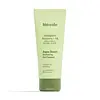What's inside
What's inside
 Key Ingredients
Key Ingredients

 Benefits
Benefits

 Concerns
Concerns

 Ingredients Side-by-side
Ingredients Side-by-side

Water
Skin ConditioningGlycerin
HumectantCocamidopropyl Betaine
CleansingPropanediol
SolventSodium Lauroyl Methyl Isethionate
CleansingXylitylglucoside
HumectantAnhydroxylitol
HumectantXylitol
HumectantPEG-150 Pentaerythrityl Tetrastearate
EmulsifyingPEG-120 Methyl Glucose Dioleate
EmulsifyingSalicylic Acid
MaskingBetaine
HumectantAvena Sativa Kernel Extract
AbrasivePentylene Glycol
Skin ConditioningCapryloyl Salicylic Acid
ExfoliatingPanthenol
Skin ConditioningAllantoin
Skin ConditioningZinc PCA
HumectantSodium PCA
HumectantCoco-Glucoside
CleansingGlyceryl Oleate
EmollientPhenoxyethanol
PreservativeEthylhexylglycerin
Skin ConditioningTrisodium Ethylenediamine Disuccinate
Lactic Acid
BufferingCitric Acid
BufferingSodium Citrate
BufferingSodium Hydroxide
BufferingWater, Glycerin, Cocamidopropyl Betaine, Propanediol, Sodium Lauroyl Methyl Isethionate, Xylitylglucoside, Anhydroxylitol, Xylitol, PEG-150 Pentaerythrityl Tetrastearate, PEG-120 Methyl Glucose Dioleate, Salicylic Acid, Betaine, Avena Sativa Kernel Extract, Pentylene Glycol, Capryloyl Salicylic Acid, Panthenol, Allantoin, Zinc PCA, Sodium PCA, Coco-Glucoside, Glyceryl Oleate, Phenoxyethanol, Ethylhexylglycerin, Trisodium Ethylenediamine Disuccinate, Lactic Acid, Citric Acid, Sodium Citrate, Sodium Hydroxide
Water
Skin ConditioningDisodium Cocoamphodiacetate
CleansingDecyl Glucoside
CleansingGlycerin
HumectantCoco-Glucoside
CleansingCocamidopropyl Hydroxysultaine
CleansingXanthan Gum
EmulsifyingPotassium Sorbate
PreservativeBetaine
HumectantGlyceryl Glucoside
HumectantXylitylglucoside
HumectantTrehalose
HumectantLactic Acid
BufferingAloe Barbadensis Leaf Juice
Skin ConditioningSaccharide Isomerate
HumectantHyaluronic Acid
HumectantSodium Gluconate
Skin ConditioningLavandula Angustifolia Oil
MaskingSodium Hyaluronate
HumectantWater, Disodium Cocoamphodiacetate, Decyl Glucoside, Glycerin, Coco-Glucoside, Cocamidopropyl Hydroxysultaine, Xanthan Gum, Potassium Sorbate, Betaine, Glyceryl Glucoside, Xylitylglucoside, Trehalose, Lactic Acid, Aloe Barbadensis Leaf Juice, Saccharide Isomerate, Hyaluronic Acid, Sodium Gluconate, Lavandula Angustifolia Oil, Sodium Hyaluronate
Ingredients Explained
These ingredients are found in both products.
Ingredients higher up in an ingredient list are typically present in a larger amount.
Betaine is a common humectant (a substance that promotes retention of moisture). It's known to be gentle on the skin and can help balance hydration.
This ingredient is best for improving hydration and soothing irritated skin. Studies also show it helps even out skin tone.
Fun fact: Betaine is naturally created in the skin and body. The kind found within cosmetic products can be either plant-derived or synthetic.
Another name for betaine is trimethylglycine.
Learn more about BetaineCoco-Glucoside is a surfactant, or a cleansing ingredient. It is made from glucose and coconut oil.
Surfactants help gather dirt, oil, and other pollutants from your skin to be rinsed away.
This ingredient is considered gentle and non-comedogenic. However, it may still be irritating for some.
Learn more about Coco-GlucosideGlycerin is already naturally found in your skin. It helps moisturize and protect your skin.
A study from 2016 found glycerin to be more effective as a humectant than AHAs and hyaluronic acid.
As a humectant, it helps the skin stay hydrated by pulling moisture to your skin. The low molecular weight of glycerin allows it to pull moisture into the deeper layers of your skin.
Hydrated skin improves your skin barrier; Your skin barrier helps protect against irritants and bacteria.
Glycerin has also been found to have antimicrobial and antiviral properties. Due to these properties, glycerin is often used in wound and burn treatments.
In cosmetics, glycerin is usually derived from plants such as soybean or palm. However, it can also be sourced from animals, such as tallow or animal fat.
This ingredient is organic, colorless, odorless, and non-toxic.
Glycerin is the name for this ingredient in American English. British English uses Glycerol/Glycerine.
Learn more about GlycerinLactic Acid is another well-loved alpha hydroxy acid (AHA). It is gentler than glycolic acid but still highly effective.
Its main role is to exfoliate the surface of the skin by loosening the “glue” that holds dead skin cells together. Shedding those old cells leads to smoother, softer, and more even-toned skin.
Because lactic acid molecules are larger than glycolic acid, they don’t penetrate as deeply. This means they’re less likely to sting or irritate, making it a great choice for beginners or those with sensitive skin.
Like glycolic acid, it can:
Lactic acid also acts as a humectant (like hyaluronic acid). It can draw water into the skin to improve hydration and also plays a role in the skin's natural moisturizing factor (NMF) in the form of sodium lactate.
Studies show it can boost ceramide production to strengthen the skin barrier and even help balance the skin’s microbiome.
To get results, choose products with a pH between 3-4.
Lower strengths (5-12%) focus on surface exfoliation; higher strengths (12% and up) can reach deeper in the dermis (deeper, supportive layer) to improve skin texture and firmness over time.
Though it was originally derived from milk, most modern lactic acid used in skincare is vegan. It is made through non-dairy fermentation to create a bio-identical and stable form suitable for all formulations.
When lactic acid shows up near the end of an ingredient list, it usually means the brand added just a tiny amount to adjust the product’s pH.
Legend has it that Cleopatra used to bathe in sour milk to help reduce wrinkles.
Lactic acid is truly a gentle multitasker: it exfoliates, hydrates, strengthens, and brightens. It's a great ingredient for giving your skin a smooth, glowing, and healthy look without the harshness of stronger acids.
Read more about some other popular AHA's here:
Learn more about Lactic AcidWater. It's the most common cosmetic ingredient of all. You'll usually see it at the top of ingredient lists, meaning that it makes up the largest part of the product.
So why is it so popular? Water most often acts as a solvent - this means that it helps dissolve other ingredients into the formulation.
You'll also recognize water as that liquid we all need to stay alive. If you see this, drink a glass of water. Stay hydrated!
Learn more about WaterXylitylglucoside is created from xylitol and glucose, two humectants.
Not surprisingly, this ingredient is also a humectant. It attracts and holds water in your skin, helping to maintain hydration.
This ingredient is most commonly found in a popular trio called Aquaxyl. Aquaxyl is made up of anhydroxylitol(24 - 34%), xylitylglucoside (35 - 50%), and xylitol (5 - 15%).
According to a manufacturer, Aquaxyl is known for a 3-D hydration concept and an anti-dehydration shield to reinforce the outer layer of skin.
Learn more about Xylitylglucoside